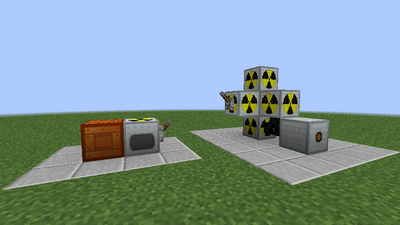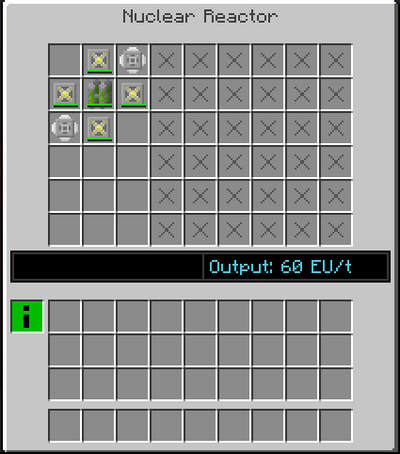| This article is a work-in-progress. It may be finished in the near future, check its history to see previous edits. |
Nuclear reactor guide
A nuclear reactor is a multiblock structure that is used to generate power for the IndustrialCraft 2 mod. Nuclear reactors can be a small as a single block and scale up to a 5x5x5 structure for Fluid Reactors.
Necessary gear
Equipping the Hazmat Suit is necessary to avoid radiation damage while holding radioactive items. Radioactive Items include all the Fuel Rods, Depleted Fuel Rods, Processed Uranium, Plutonium and Pellets of RTG Fuel.
| Hazmat Suit |
|---|
Building a nuclear reactor
A nuclear reactor is constructed by placing a Nuclear Reactor block, and optionally surrounding it with up to 6 Reactor Chambers. Right-click on the reactor to access its internal inventory, which will be a grid that is 3x6 (for a single reactor block) to 9x6 (for a full 6 reactor chamber build). Place Fuel Rods in the grid along with other reactor components. Applying a redstone signal to any part of the nuclear reactor will turn it on, and the Fuel Rods will start to generate heat and Energy Units (EU). Generated EU is not stored; if there is no cable or EU storage device with free capacity attached to the reactor the generated EU will be lost.
Fuel Rods
Uranium Fuel Rods are crafted in a Fluid/Solid Canning Machine and can be crafted into Dual Fuel Rod (Uranium) or Quad Fuel Rod (Uranium). Fuel Rods have a durability value proportional to their lifespan in seconds. Uranium Fuel Rods have a starting damage value of 20,000. A single fuel rod in a reactor will generate 5EU/t and 4 Heat Units per second (HU/s) and consequently produce 2,000,000 EU over its 20,000 second working life. Fuel Rods multiply both their EU output AND their Heat output as a result of being adjacent to other fuel rods or sources of neutrons such as Neutron Reflectors. The EU efficiency of a Fuel Rod starts at 1, and increases by 1 for each adjacent neutron source, and the Heat Output is computed as where is the number of adjacent rods.
| Adjacent Rods | Efficiency (EU) | EU/t | Heat |
|---|---|---|---|
| 0 | 1 | 5 | 4 |
| 1 | 2 | 10 | 12 |
| 2 | 3 | 15 | 24 |
| 3 | 4 | 20 | 40 |
| 4 | 5 | 25 | 60 |
| 5 | 6 | 30 | 84 |
| 6 | 7 | 35 | 112 |
Note that a Dual Fuel Rod counts as two fuel rods (that are each adjacent to a fuel rod), and a Quad Fuel Rod counts as four fuel rods arranged so each fuel rod are adjacent to two others in its group. However, groups of Dual and Quad Fuel Rods that are cardinally adjacent to one another will add 1 to the efficiency score of a fuel rod, which means the maximum achievable efficiency among groups of Dual or Quad Fuel Rods is 7: A Quad Fuel Rod (with a base efficiency of 3) with another fuel rod or neutron source in each cardinal direction will receive an additional +4 to its efficiency.
Components
In an operating nuclear reactor Fuel Rods will try to dump all their generated heat into adjacent components first if those components accept heat (i.e. must have a durability). If there are no suitable adjacent components, the heat is instead diverted into the reactors hull. The reactors hull has a default heat capacity of 10,000—exceeding this will cause the reactor to explode with devastating consequences. A typical explosion will destroy most blocks around the reactor within a 32-block radius in all directions. Additionally, at Hull temperatures starting at 40% of the max heat capacity, the reactor will start to set fire to blocks around itself, damage entities and so on. At 85% blocks in a 7x7x7 area around the reactor will start turning into Lava. Ensure a full Hazmat Suit is equipped when near a hot reactor to mitigate the character damaging effects.
Therefore, it is important to vent excess heat from the reactor, which can be done with reactor components. Components can vent heat into the air around the reactor, transfer heat from the hull into themselves, and exchange heat with their neighbors. If, for any reason, more heat is transferred into a component that transferred out, this is represented as damage to the component; damaged components will self-repair if given the opportunity to transfer more heat out than in, such as if a overheating reactor is turned off. (This is the basis of unstable reactors, which are run with a pulsed on-off cycle).
| Component | Hull | Component | Vent (HU/s) | Accepts Heat | Comment |
|---|---|---|---|---|---|
| - | - | 6 | 1000 | This simple component will accept heat and vent up to 6 HU/s. | |
| - | - | 12 | 1000 | Can accept twice as much heat as a Heat Vent. | |
| 5 | - | 5 | 1000 | This component can be used to remove 5 HU/s from the reactor hull and vent it. | |
| 36 | - | 20 | 1000 | This component cools the Hull for a massive 36 HU/s, but only vents 20 HU/s. | |
| - | 4 | = | - | This component cools each cardinally adjacent component for up to 4 HU/s and vents it directly. | |
| 4 | 12 | - | 2500 | ||
| 8 | 24 | - | 10000 | ||
| 72 | - | - | 5000 | ||
| - | 36 | - | 5000 | Balances the heat in its surrounding components. |
Filling a Simple Reactor
This is a simple, tileable, design for a reactor that emits exactly 60 EU/t. The heat generated is 96 HU/s, which is shared equally between the 4 Overclocked Heat Vents, giving them 24 HU/s each. These heat vents can self cool up to 20 HU/s leaving an excess of 4 HU/s. Two Component Heat Vents deal with this excess as they happen to be able to vent 4 HU/s from each adjacent component.
This design can be tiled up to 6 times in a reactor, providing 60 to 360 EU/t.
Building a MOX reactor
MOX reactors are nuclear reactors that are fueled with Fuel Rod (MOX), Dual Fuel Rod (MOX), or Quad Fuel Rod (MOX). These fuel rods only have a durability value of 10,000 and last half as long as Uranium-based Fuel Rods. However, they gain bonus efficiency from the Reactor's Hull heat. The bonus scales from 1x (none) at 0% Heat linearly to 5x at 100% Heat.
Simple MOX reactors can be made by pre-heating an empty reactor with one Quad Fuel Rod (Uranium) and no cooling. A single quad fuel rod generates 96 HU/s, which means it will take 78 seconds to add 7500 Hull Heat to the reactor, which gives a bonus efficiency of x4 to EU production. Then, fill the reactor with a stable design that includes no components that cool the Hull.
Example: A single Quad Fuel Rod (MOX) produces a cumulative 96 HU/t and 60 EU/t in a cold reactor. In a reactor heated to 75% it instead provides 240 EU/t.
The following components ar typically used for cooling in reactors that maintain a stable Hull Heat level.
| Components to use in Stable MOX reactors |
|---|
Building a fluid reactor with Stirling Generators
Fluid reactors are a 5x5x5 multiblock structure. They do not produce EU/t but rather HU/t and the heat output is doubled. When coupled to a Stirling Generator 2 HU generates 1 EU. e.g. A single Quad Fuel Rod in a regular reactor produces 60EU/t and 96 HU/t. In a fluid reactor, it will generate 192 HU/t which will require 2 Liquid Heat Exchangers (each of which transfers a max of 100 HU/t) that will produce 96 EU/t in coupled Stirling Generators.
Building a fluid reactor with Steam Turbines
A properly heated and configured Steam Boiler will use 1mB of Water or Distilled Water to create 100mB of Superheated Steam per HU. For Superheated Steam rather than just Steam the Steam Boiler's output pressure must be set to at least 221 kPa.
A Steam Turbine will produce enough kinetic energy per 100mB of Superheated Steam that when coupled to a Kinetic Generator will produce 100 EU/t, converting the Superheated Steam into regular Steam in the process. Steam is ejected into an adjacent Steam Turbine automatically. The second Steam Turbine will produce 50 EU/t per 100mB of input Steam.
e.g. A single Quad Fuel Rod in a fluid reactor produces 192 HU/s. Adding regular Water or Distilled Water into a single Steam Boiler configured to output a pressure of at least 221 kPa will produce Superheated Steam, generating 96 EU/t in the first Steam Turbine and an additional 48 EU/t in the second for a total output of 144 EU/t. This is more than double the output of the same Fuel Rod in a regular reactor (60 EU/t).
MOX Fuel in a fluid reactor
In a standard nuclear reactor MOX fuel rods boost their EU output, but not heat output, in response to reactor hull heat. In fluid reactors the EU output is ignored, and getting MOX fuel rods to scale their output heat with the reactors heat would make for a dangerously unstable setup. However, MOX fuel rods will double their heat output if the reactor is heated above 50%.
As an example, a single Quad Fuel Rod (MOX) in a Fluid reactor heated to 75% would be generating 432 HU/s. This will create sufficient Superheated Steam to generate 288 EU/t.
See also
- The Nuclear Engineering board on the IC2 forums
- GitHub repository for planning nuclear reactor construction
| ||||||||||||||||||||||||||||||||||||||||||||||||||||||||||||||||||||||||||||||||||||||||||||||||||||||||||||||||||||||||||||||||||||||||||||||||||||||||||||||||||||||||||||||||||||||||||||||||||||||||||||||||||||||||||||||||||||||||||||||||||||||||||||||||||||||||||||




